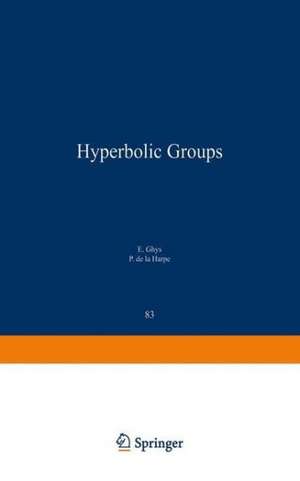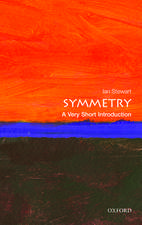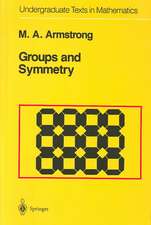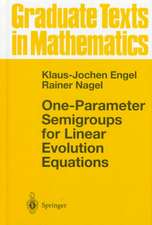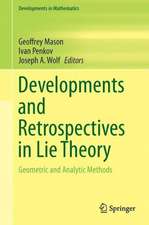Sur les Groupes Hyperboliques d’après Mikhael Gromov: Progress in Mathematics, cartea 83
Editat de Etienne Ghys, Pierre da la Harpeen Limba Engleză Paperback – 1990
This monograph is intended to be an introduction to part of Gromov's theory, giving basic definitions, some of the most important examples, various properties of hyperbolic groups, and an application to the construction of infinite torsion groups. The main theme is the relevance of geometric ideas to the understanding of finitely generated groups. In addition to chapters written by the editors, contributions by W. Ballmann, A. Haefliger, E. Salem, R. Strebel, and M. Troyanov are also included.
The book will be particularly useful to researchers in combinatorial group theory, Riemannian geometry, and theoretical physics, as well as post-graduate students interested in these fields.
Din seria Progress in Mathematics
- 24%
 Preț: 687.36 lei
Preț: 687.36 lei - 24%
 Preț: 740.80 lei
Preț: 740.80 lei - 9%
 Preț: 763.33 lei
Preț: 763.33 lei -
 Preț: 308.20 lei
Preț: 308.20 lei - 20%
 Preț: 695.88 lei
Preț: 695.88 lei -
 Preț: 362.51 lei
Preț: 362.51 lei -
 Preț: 308.13 lei
Preț: 308.13 lei - 18%
 Preț: 749.27 lei
Preț: 749.27 lei - 9%
 Preț: 766.42 lei
Preț: 766.42 lei - 20%
 Preț: 631.09 lei
Preț: 631.09 lei - 24%
 Preț: 638.88 lei
Preț: 638.88 lei - 15%
 Preț: 580.82 lei
Preț: 580.82 lei -
 Preț: 392.37 lei
Preț: 392.37 lei -
 Preț: 395.09 lei
Preț: 395.09 lei -
 Preț: 390.25 lei
Preț: 390.25 lei -
 Preț: 376.80 lei
Preț: 376.80 lei - 18%
 Preț: 729.53 lei
Preț: 729.53 lei - 15%
 Preț: 652.49 lei
Preț: 652.49 lei - 15%
 Preț: 649.22 lei
Preț: 649.22 lei - 18%
 Preț: 897.95 lei
Preț: 897.95 lei -
 Preț: 385.08 lei
Preț: 385.08 lei -
 Preț: 391.02 lei
Preț: 391.02 lei -
 Preț: 378.54 lei
Preț: 378.54 lei - 15%
 Preț: 531.59 lei
Preț: 531.59 lei - 15%
 Preț: 642.83 lei
Preț: 642.83 lei - 15%
 Preț: 650.69 lei
Preț: 650.69 lei -
 Preț: 381.21 lei
Preț: 381.21 lei -
 Preț: 392.37 lei
Preț: 392.37 lei -
 Preț: 398.53 lei
Preț: 398.53 lei - 15%
 Preț: 699.28 lei
Preț: 699.28 lei -
 Preț: 416.92 lei
Preț: 416.92 lei -
 Preț: 385.84 lei
Preț: 385.84 lei - 18%
 Preț: 902.65 lei
Preț: 902.65 lei - 18%
 Preț: 802.28 lei
Preț: 802.28 lei - 15%
 Preț: 640.06 lei
Preț: 640.06 lei - 18%
 Preț: 1129.83 lei
Preț: 1129.83 lei
Preț: 693.06 lei
Preț vechi: 815.37 lei
-15% Nou
Puncte Express: 1040
Preț estimativ în valută:
132.66€ • 144.15$ • 111.51£
132.66€ • 144.15$ • 111.51£
Carte tipărită la comandă
Livrare economică 21 aprilie-05 mai
Preluare comenzi: 021 569.72.76
Specificații
ISBN-13: 9780817635084
ISBN-10: 0817635084
Pagini: 287
Ilustrații: XI, 287 p.
Dimensiuni: 127 x 203 x 16 mm
Greutate: 0.31 kg
Editura: Birkhäuser Boston
Colecția Birkhäuser
Seria Progress in Mathematics
Locul publicării:Boston, MA, United States
ISBN-10: 0817635084
Pagini: 287
Ilustrații: XI, 287 p.
Dimensiuni: 127 x 203 x 16 mm
Greutate: 0.31 kg
Editura: Birkhäuser Boston
Colecția Birkhäuser
Seria Progress in Mathematics
Locul publicării:Boston, MA, United States
Public țintă
ResearchTextul de pe ultima copertă
The theory of hyperbolic groups has its starting point in a fundamental paper by M. Gromov, published in 1987. These are finitely generated groups that share important properties with negatively curved Riemannian manifolds.
This monograph is intended to be an introduction to part of Gromov's theory, giving basic definitions, some of the most important examples, various properties of hyperbolic groups, and an application to the construction of infinite torsion groups. The main theme is the relevance of geometric ideas to the understanding of finitely generated groups. In addition to chapters written by the editors, contributions by W. Ballmann, A. Haefliger, E. Salem, R. Strebel, and M. Troyanov are also included.
The book will be particularly useful to researchers in combinatorial group theory, Riemannian geometry, and theoretical physics, as well as post-graduate students interested in these fields.
